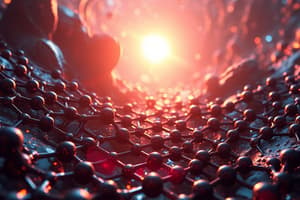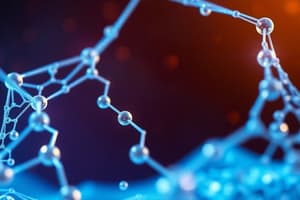Podcast
Questions and Answers
What is one mechanical method for producing graphene mentioned in the content?
What is one mechanical method for producing graphene mentioned in the content?
Exfoliating graphite using scotch tape.
Describe the process of Chemical Vapour Deposition (CVD) for producing graphene.
Describe the process of Chemical Vapour Deposition (CVD) for producing graphene.
Epitaxial growth on SiC or metal using methane as a carbon source under H2 conditions.
What is a key advantage of graphene's electrical properties at room temperature?
What is a key advantage of graphene's electrical properties at room temperature?
High electron mobility, making it desirable for electronic devices.
What is unique about the bandgap of pristine graphene?
What is unique about the bandgap of pristine graphene?
How can the Fermi level of graphene be tuned, and why is this significant?
How can the Fermi level of graphene be tuned, and why is this significant?
What is the relationship between mobility, average velocity, and electric field in graphene?
What is the relationship between mobility, average velocity, and electric field in graphene?
How does graphene's optical absorption compare to that of conventional materials?
How does graphene's optical absorption compare to that of conventional materials?
What value is attributed to graphene's tensile strength, and how does it compare to diamond?
What value is attributed to graphene's tensile strength, and how does it compare to diamond?
Describe the significance of Young's modulus in the context of graphene.
Describe the significance of Young's modulus in the context of graphene.
What makes graphene particularly advantageous in terms of its electrical properties?
What makes graphene particularly advantageous in terms of its electrical properties?
Flashcards are hidden until you start studying
Study Notes
Graphene Production Techniques
- Graphene can be produced using two methods: Mechanical Exfoliation and Chemical Vapor Deposition
- Mechanical exfoliation involves using scotch tape to peel off layers of graphite
- Chemical Vapor Deposition (CVD) uses methane as a carbon source in a hydrogen environment to grow graphene epitaxially on silicon carbide or metal surfaces
- Roll-to-roll production of 30-inch graphene films enables large-scale production of graphene for transparent electrodes
Graphene Properties
- Pristine graphene is a semi-metal with zero bandgap
- Graphene's Fermi level can be tuned by electrical or chemical doping
- Electrical doping tunes the Fermi level, while chemical doping can also open up a bandgap and tune the Fermi level
- Graphene exhibits high electron mobility at room temperature, a desirable property for electronic devices
- Graphene has an optical transmittance control property, allowing for its use as a transparent electrode
- Single-layer graphene absorbs 2.3% of light
- Graphene boasts exceptional mechanical strength, suitable for flexible and stretchable devices
- Graphene's Young's modulus is 1 terapascal (TPa), making it exceptionally strong
- Graphene possesses a low density of 2 g/cm3 and a high specific surface area, approaching its theoretical limit of 2630 m2/g
- Graphene is very resistant to fracture, with a tensile strength of 130 gigapascals (GPa)
- Graphene is an excellent thermal conductor with a thermal conductivity exceeding 4800 W/m/K due to its unique phonon effects
- Graphene's electrical properties include high electron mobility up to 15000 cm2/Vs and exhibits the quantum Hall effect
Application of Graphene
- Graphene is used in the creation of touch screen panels.
Fullerene Structures
- Fullerenes are molecules composed of carbon atoms arranged in a spherical, ellipsoidal, or tubular structure
- The smallest fullerene is C20, while larger ones exist up to C300
- The most common fullerene is C60
- Various isomers of fullerenes exist, with C20, C24, C28, C32, C36, and C50 being notable examples
Fullerene Properties
- C60 has a structure resembling a truncated icosahedron, similar to a soccer ball
- C60 contains 20 hexagons and 12 pentagons
- C60 exhibits sp2 bonds on its spherical surface and weaker pi bonds within the orbitals perpendicular to the surface
- The diameter of C60 is 0.71 nanometers
- Fullerenes are stable molecules, but not entirely unreactive
- Fullerenes are soluble in aromatic solvents
- Fullerenes exhibit superconductivity
- Fullerene's electronic properties include a band gap, which is influenced by the fullerene size and substrate
- The band gap of fullerene is comparable to the electronic band gap observed in bulk semiconductors
- Changing the size of the fullerene or the substrate can modify the band gap of fullerene molecules
Fullerene Electronic Properties
- The HOMO-LUMO (Highest Occupied Molecular Orbital – Lowest Unoccupied Molecular Orbital) gap of fullerene varies depending on the molecule and its environment
- The HOMO-LUMO gap can range from 1.75 eV for free C60 to 2.7 eV for C60 on a gold (Au) substrate.
Studying That Suits You
Use AI to generate personalized quizzes and flashcards to suit your learning preferences.




